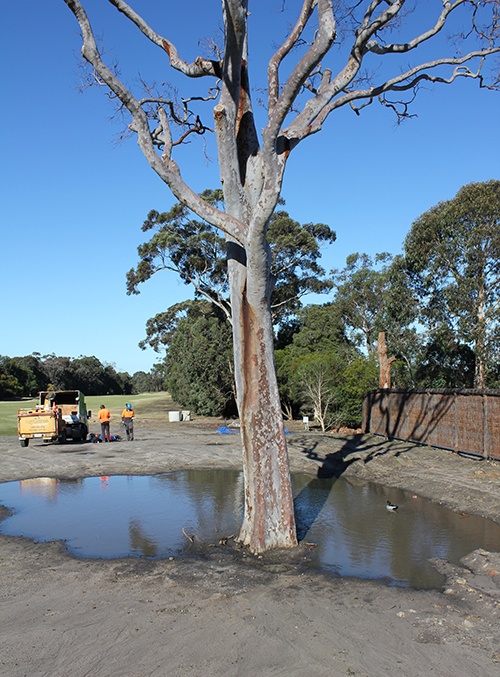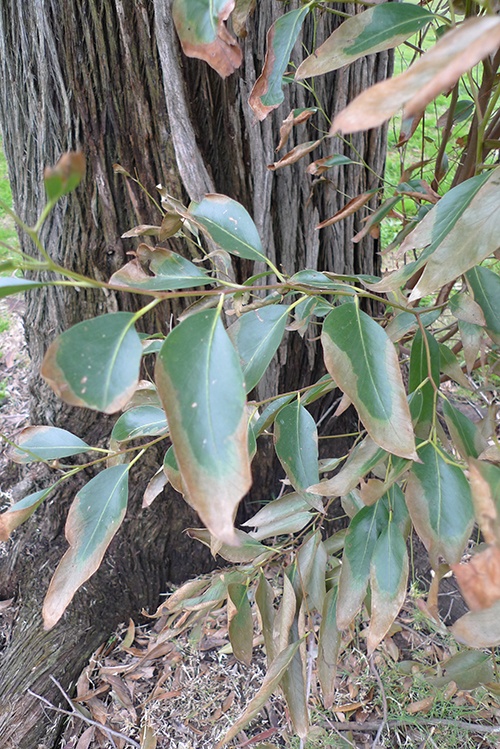-
Saturated or waterlogged soils occur when the spaces between the soil particles fill with water quicker than the water can drain away or evaporate into the atmosphere. The immediate effect of waterlogging is to starve roots of oxygen required for respiration. However, sustained periods of waterlogging changes the types of soil biota present, altering plant nutrient availability and leading to the production and accumulation of gases, some of which are toxic to trees.

Unless your garden is in a flood prone area, rain-induced waterlogging often does not last long enough to have a serious impact on most trees. Waterlogging, however, may not always be obvious underfoot and trees can be damaged by sub-surface waterlogging when normal moisture conditions occur at the soil surface. Causes can include; planting in low lying areas on poorly draining soils, broken or leaking water/irrigation pipes, overwatering (especially newly planted trees), or sudden changes to site drainage. Often with sub-surface waterlogging, by the time a problem is realised, affected trees have already been damaged.
Symptoms and Impacts
Symptoms of waterlogging can include; the wilting of shoots and leaves, browning (scorching) of leaf margins, yellowing or paleness and mottling of older leaves, while leaf drop (older leaves first) may also result. In acute cases of waterlogging rapid leaf death leaves brittle green leaves. Prolonged waterlogging causes reduced or stunted growth and can result in root decay, rendering trees susceptible to windthrow.
Trees stressed by waterlogging are also susceptible to attack from opportunistic pests and diseases. Waterlogged soils provide ideal infection conditions group of fungi called water molds that include Phytopthora and Pythium, two potentially serious diseases capable of causing rapid tree decline and even tree death.

While waterlogging can be fatal to any tree, many species have adapted to tolerate short periods of waterlogging, with some even able to tolerate prolonged waterlogging. Individual responses depend on the time of year and duration of the waterlogging, the attributes of the species, tree life stage and health, water quality and oxygen levels. Established and healthy trees are generally more tolerant of waterlogging than old, unhealthy, or very young trees of the same species, while waterlogging during periods of growth tends to be more harmful than during period of plant dormancy.
What to do
After isolated occurrences of waterlogging, repairing the damage should focus on the improving tree and soil health. Suggestions include:
- Applying a light dose of nitrogen, potassium and phosphorous.
- Avoiding the application of micro-nutrients.
- Avoiding pruning that removes live foliage or foliage bearing branches.
- Applying mulch to the tree root zone as this can encourage the return beneficial soil organisms and improve soil nutrient availability.
Where a site is prone to periodic or extended waterlogging, raising soil levels and/or installing drainage can be used to improve site conditions. The latter however is often unrealistic to apply on a large scale and replacing or selecting trees tolerant of waterlogging can provide a more practical solution.
The following provides examples of ornamental tree species tolerant of temporary waterlogging:
Small trees (<8m) Buxton Gum Eucalyptus crenulata Australian native Cup Gum Eucalyptus cosmophylla Australian native Harkness Bottlebrush Callistemon ‘Harkness’ Australian native Kings Park Special Bottlebrush Callistemon ‘Kings Park Special’ Australian native Lemon-scented Tea-tree Leptospermum pertsersonii Australian native Plunkett Mallee Eucalyptus curtisii Australian native Scented Paperbark Melaleuca squarrosa, Australian native Silver Banksia Banksia marginata Australian native Swamp Paperbark Melaleuca ericifolia, Australian native Water Gum Tristaniopsis laurina Australian native Weeping Bottlebrush Callistemon viminalis Australian native Medium trees (9-15m) Argyle Apple Eucalyptus cinerea Australian native Black Tupelo Nyssa sylvatica Exotic deciduous Blueberry Ash Elaeocarpus reticulatus Australian native Callery Pear varieties (Pyrus calleryana var.) Exotic deciduous Freeman Maple varieties Acer freemanii Exotic deciduous River Birch Betula nigra Exotic deciduous Scrub Cherry Syzygium australe Australian native Snow in Summer Melaleuca linariifolia Australian native Swamp Mallet Eucalyptus spathulata Australian native Swamp White Oak Quercus bicolor Exotic deciduous Large trees (>15m) Broad-leaved Paperbark Melaleuca quinquenervia, Australian native Dawn Redwood Metasequoia glyptostroboides Exotic deciduous Green Ash Fraxinus pennsylvanica Exotic deciduous Pin Oak Quercus palustris Exotic deciduous Prickly-leafed Paperbark Melaleuca stypheloides Australian native River Red Gum Eucalyptus camaldulensis Australian native River She-Oak Casuarina cunninghamiana Australian native Spotted Gum Corymbia maculata Australian native Sweetgum Liquidambar styraciflua Exotic deciduous




